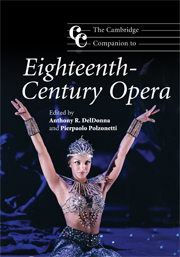Book contents
- Frontmatter
- Part I The making of opera
- Part II National styles and genres
- 9 Genre and form in French opera
- 10 Genre and form in German opera
- 11 Opera in eighteenth-century England: English opera, masques, ballad operas
- 12 Opera in Naples
- 13 Portugal and Brazil
- 14 Opera, genre, and context in Spain and its American colonies
- Notes
- Bibliography
- Index
13 - Portugal and Brazil
from Part II - National styles and genres
Published online by Cambridge University Press: 28 September 2011
- Frontmatter
- Part I The making of opera
- Part II National styles and genres
- 9 Genre and form in French opera
- 10 Genre and form in German opera
- 11 Opera in eighteenth-century England: English opera, masques, ballad operas
- 12 Opera in Naples
- 13 Portugal and Brazil
- 14 Opera, genre, and context in Spain and its American colonies
- Notes
- Bibliography
- Index
Summary
The reign of John V
During the seventeenth century, Portuguese musical practice had remained essentially confined within the limits of the Iberian repertory. The arrival of Italian music and opera in the country in the first quarter of the eighteenth century, at a time when it was rapidly becoming the main international tradition all across Europe, was a direct consequence of the changes in Portuguese musical life and institutions brought about by the artistic and cultural policies of King John V, who reigned from 1707 to 1750. Confronted with the power and dominance that the Catholic Church had acquired during the previous century, the king tried to curb this power by appropriating it himself. To this effect he invested a significant part of the crown's new wealth connected with the discovery of gold in Brazil in the prestige of the religious establishment in general and of his own royal chapel in particular, which he managed to elevate to the status of patriarchal see at the beginning of his reign. In the ironic words of Frederick II of Prussia, “Priestly functions were his amusements, monks his armies, convents his buildings, and nuns his mistresses.”
The reform of musical institutions and the importation of Italian musicians are directly connected with the reform of the chapel, in an attempt to make it emulate the Papal Chapel. Several papal singers, and in 1719 the master of the Cappella Giulia of the Vatican himself, Domenico Scarlatti, were hired for the Portuguese chapel, which in 1730 had as many as 26 Italian singers. A court orchestra was also formed whose main members were foreigners, some of whom established dynasties of court players which were to last up to the second quarter of the nineteenth century. In 1713 a music school was created adjoining the chapel, the Seminário da Patriarcal, which would remain the main music school in the country during the whole eighteenth century.
- Type
- Chapter
- Information
- The Cambridge Companion to Eighteenth-Century Opera , pp. 233 - 243Publisher: Cambridge University PressPrint publication year: 2009



